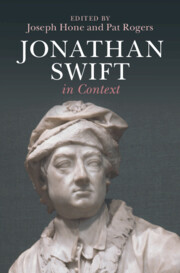Book contents
- Jonathan Swift in Context
- Jonathan Swift in Context
- Copyright page
- Contents
- Notes on Contributors
- Preface
- Acknowledgements
- Chronology
- Abbreviations
- Part I Personal
- Part II Publishing History and Legacy
- Part III Literary Background
- Chapter 11 Ancients and Moderns
- Chapter 12 Travel and Exploration
- Chapter 13 Profession of Letters
- Chapter 14 Women Writers
- Chapter 15 Style and Language
- Part IV Genres
- Part V The External World
- Part VI Social and Intellectual Topics
- Further Reading
- Index
Chapter 11 - Ancients and Moderns
from Part III - Literary Background
Published online by Cambridge University Press: 02 May 2024
- Jonathan Swift in Context
- Jonathan Swift in Context
- Copyright page
- Contents
- Notes on Contributors
- Preface
- Acknowledgements
- Chronology
- Abbreviations
- Part I Personal
- Part II Publishing History and Legacy
- Part III Literary Background
- Chapter 11 Ancients and Moderns
- Chapter 12 Travel and Exploration
- Chapter 13 Profession of Letters
- Chapter 14 Women Writers
- Chapter 15 Style and Language
- Part IV Genres
- Part V The External World
- Part VI Social and Intellectual Topics
- Further Reading
- Index
Summary
From the start of his career, Jonathan Swift was caught up in debates about the relative value of ancient and modern cultures. Swift’s first masterpieces, ‘The Battel of the Books’ and A Tale of a Tub (both pub. 1704), were brilliant satirical interventions on the side of ancient cultures against the moderns. This chapter unpicks the density of allusion in these works, explaining how they relate to the broader ‘quarrel’ between the ancients and moderns. A final section traces the legacy of this dispute in Gulliver’s Travels (1726), in which Swift invokes ancient Sparta as a model for social integrity.
- Type
- Chapter
- Information
- Jonathan Swift in Context , pp. 85 - 92Publisher: Cambridge University PressPrint publication year: 2024

